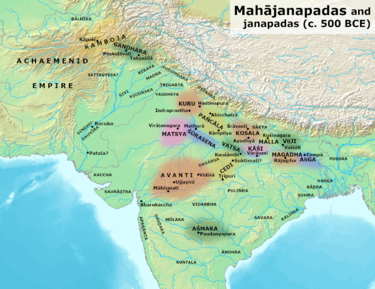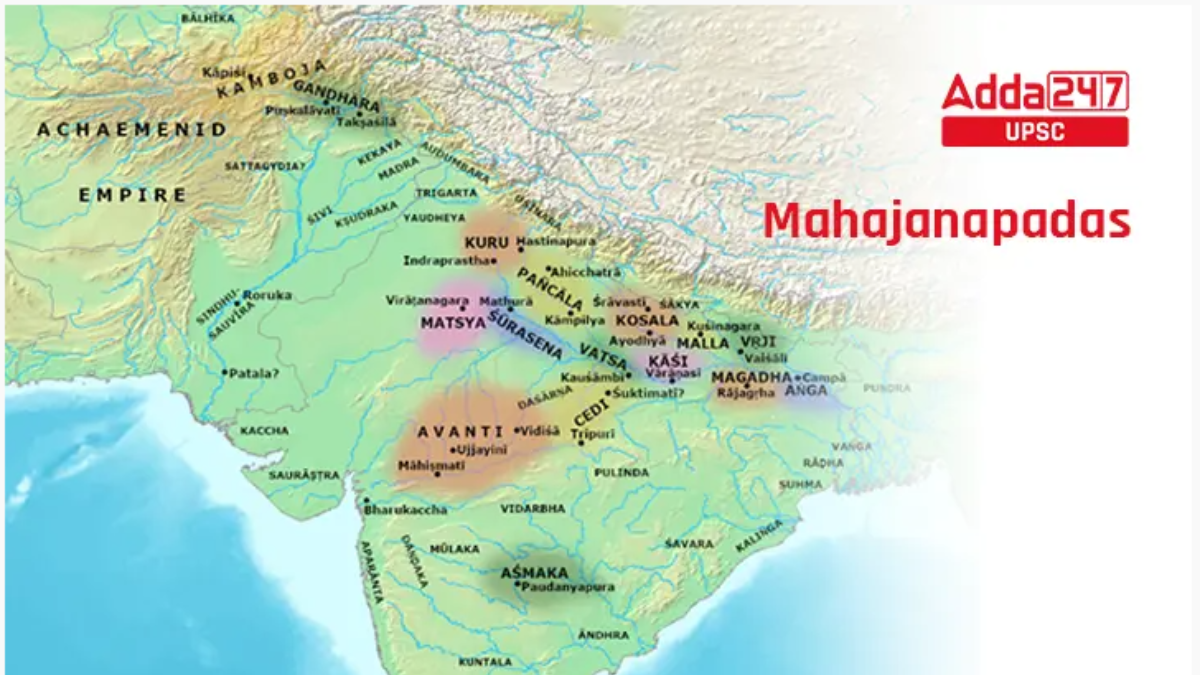Table of Contents
The 16 Mahajanapadas were a group of ancient kingdoms that emerged in the Indian subcontinent around the 6th century BCE. These powerful and prosperous states played a significant role in shaping the political, social, and cultural landscape of India during that time.
For UPSC students, understanding the Mahajanapadas is crucial, as it forms an essential part of the ancient Indian history and culture syllabus, which is a key component of the Civil Services Examination. In this article, we will delve into the history and significance of the 16 Mahajanapadas, examining their rise and fall, and their enduring impact on the Indian subcontinent. By exploring these ancient kingdoms, students can gain a deeper appreciation of India’s historical foundations and the complexities of its early political systems.
What are Mahajanapadas?
The term “Mahajanapadas” refers to the sixteen powerful and influential kingdoms that existed in ancient India between the 6th and 4th centuries BCE. The word is made up of two Sanskrit terms: “maha,” meaning great or large, and “janapada,” which means a region or territory.
These kingdoms were spread across different parts of the Indian subcontinent, and their territories often overlapped. Some of the most important Mahajanapadas were Magadha, Kosala, Vajji, Avanti, and Kuru. These kingdoms played a key role in shaping the history and culture of ancient India.
The Mahajanapadas had a significant impact on the political and cultural landscape of ancient India. They played a crucial role in shaping the course of Indian history, influencing everything from governance and trade to religion and social structures. Understanding these kingdoms helps us appreciate the rich tapestry of India’s early history and the foundations of its civilization.
16 Mahajanapadas Map

Names of 16 Mahajanapadas and Capital
The 16 Mahajanapadas were a group of ancient kingdoms that existed in the Indian subcontinent during the 6th to 4th centuries BCE. These were powerful and prosperous states that played a crucial role in shaping the course of Indian history. Each Mahajanapada had its own unique culture, language, and administrative system, and some of them were known for their military prowess and territorial expansion.
| Mahajanapada | Capital | Current Location |
|---|---|---|
| Anga | Champa | Bhagalpur district, Bihar |
| Assaka | Potana | Maharashtra |
| Avanti | Ujjayini | Ujjain, Madhya Pradesh |
| Chedi | Suktimati | Bundelkhand region, Madhya Pradesh |
| Gandhara | Taxila | Peshawar valley, Pakistan |
| Kamboja | Rajapura | Northern Pakistan |
| Kashi | Varanasi | Varanasi, Uttar Pradesh |
| Kosala | Ayodhya | Faizabad, Uttar Pradesh |
| Kuru | Indraprastha | Delhi and Haryana |
| Magadha | Rajgriha | Bihar |
| Malla | Kushinagar | Eastern Uttar Pradesh |
| Matsya | Viratanagara | Alwar, Rajasthan |
| Panchala | Ahichhatra | Bareilly, Uttar Pradesh |
| Surasena | Mathura | Mathura, Uttar Pradesh |
| Vajji | Vaishali | Muzaffarpur, Bihar |
| Vatsa | Kausambi | Allahabad, Uttar Pradesh |
Political Structure of the Mahajanapadas
- The Mahajanapadas were characterized by a decentralized political structure, with each kingdom having its own king and administrative system.
- The king was the most important figure in the Mahajanapada’s political hierarchy, and his authority was often absolute.
- The king was supported by a council of ministers and advisers, who helped him govern the kingdom and make important decisions.
- The Mahajanapadas had a well-developed system of taxation, which helped finance the kingdom’s military and administrative expenses.
- The Mahajanapadas were often engaged in warfare with each other, and military prowess played a significant role in determining a kingdom’s power and influence.
- Some of the Mahajanapadas were known for their sophisticated administrative and legal systems. For example, the kingdom of Magadha had a complex system of taxation, land measurement, and trade regulation.
- The Mahajanapadas were also characterized by a high degree of social and economic stratification, with the king and nobility occupying the top of the social hierarchy and the common people at the bottom.
- The Mahajanapadas had a diverse population, with people from different castes, religions, and ethnic groups living within their boundaries.
- Despite their decentralized political structure, the Mahajanapadas were able to establish a degree of cultural and linguistic unity across the Indian subcontinent, which helped lay the foundation for later empires and kingdoms.
Facts on 16 Mahajanapadas
- The 16 Mahajanapadas were a group of ancient kingdoms that existed in the Indian subcontinent between the 6th and 4th centuries BCE.
- The term “Mahajanapada” comes from two Sanskrit words, “maha” meaning great and “janapada” meaning foothold of a tribe.
- The Mahajanapadas were located across different parts of the Indian subcontinent, with their boundaries often overlapping each other.
- The Mahajanapadas had a decentralized political structure, with each kingdom having its own king and administrative system.
- Some of the famous Mahajanapadas include Magadha, Kosala, Vajji, Avanti, and Kuru.
- The Mahajanapadas were often engaged in warfare with each other, and military prowess played a significant role in determining a kingdom’s power and influence.
- The Mahajanapadas had a diverse population, with people from different castes, religions, and ethnic groups living within their boundaries.
- The Mahajanapadas were known for their sophisticated administrative and legal systems. For example, the kingdom of Magadha had a complex system of taxation, land measurement, and trade regulation.
- The Mahajanapadas were centers of trade, commerce, and agriculture, with some kingdoms being famous for their production of goods such as silk, iron, and textiles.
- The Mahajanapadas made significant contributions to the fields of art, literature, philosophy, and religion, with important figures such as the Buddha and
- Mahavira emerged during this period.
- The Mahajanapadas played a crucial role in shaping the course of Indian history and laid the foundation for later empires and kingdoms such as the Mauryan and Gupta Empires.
Who was the founder of Mahajanapadas?
The Mahajanapadas were not founded by a single individual but rather emerged over time through a process of political and social evolution in the Indian subcontinent during the 6th to 4th centuries BCE.
Each Mahajanapada had its own unique history and origins and was often the result of the consolidation of smaller kingdoms or the rise of new political entities. For example, the kingdom of Magadha is said to have emerged through the conquests of its early rulers, while the Vajji confederacy was formed through the alliance of several tribal republics.
Therefore, the Mahajanapadas did not have a single founder or creator but rather emerged as a result of complex historical and political factors.
Difference between Janapadas and Mahajanapadas?
Janapadas and Mahajanapadas were both ancient Indian kingdoms, but there is a difference between the two. Janapadas were smaller kingdoms or territories in ancient India, which emerged during the Vedic period (1500 BCE-600 BCE). They were often ruled by a king or a chieftain, and their territories were usually small, with limited resources and a simple social and economic structure.
The Mahajanapadas were bigger and more developed kingdoms that appeared in India around the 6th century BCE. These kingdoms had strong central governments, advanced trade systems, a clear social hierarchy, and powerful armies. They were the first large political states in India and often fought with each other.
| Related Articles | |
| Maharana Pratap Biography | |
| Mauryan Empire | |
| Ganga River System | Chipko Movement |



 TSPSC Group 1 Question Paper 2024, Downl...
TSPSC Group 1 Question Paper 2024, Downl...
 TSPSC Group 1 Answer key 2024 Out, Downl...
TSPSC Group 1 Answer key 2024 Out, Downl...
 UPSC Prelims 2024 Question Paper, Downlo...
UPSC Prelims 2024 Question Paper, Downlo...





